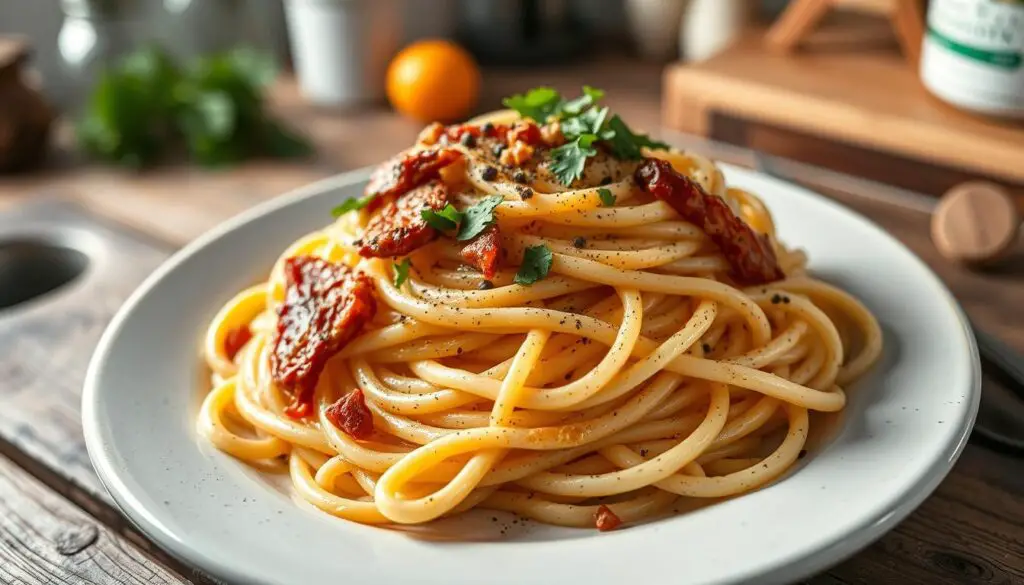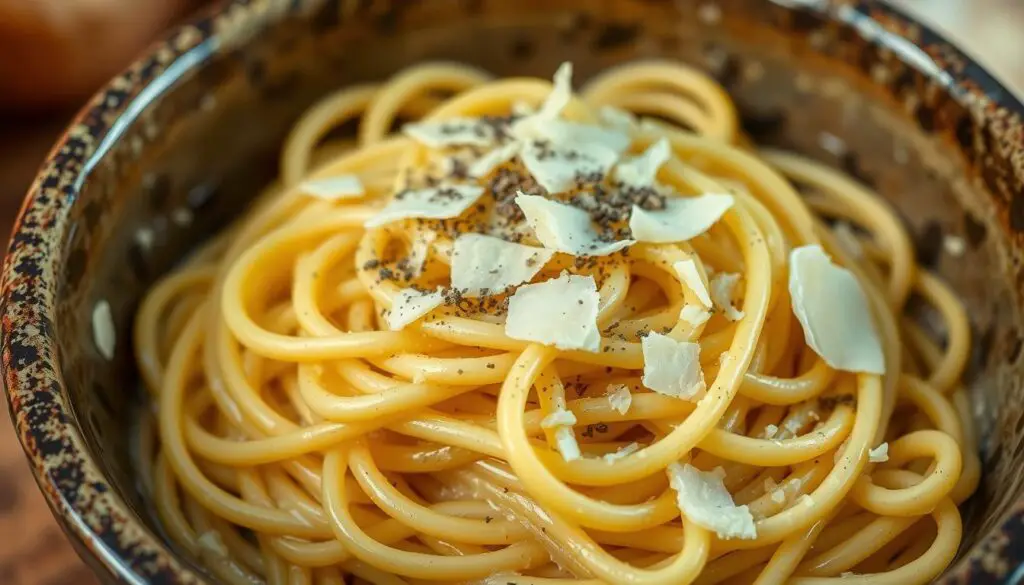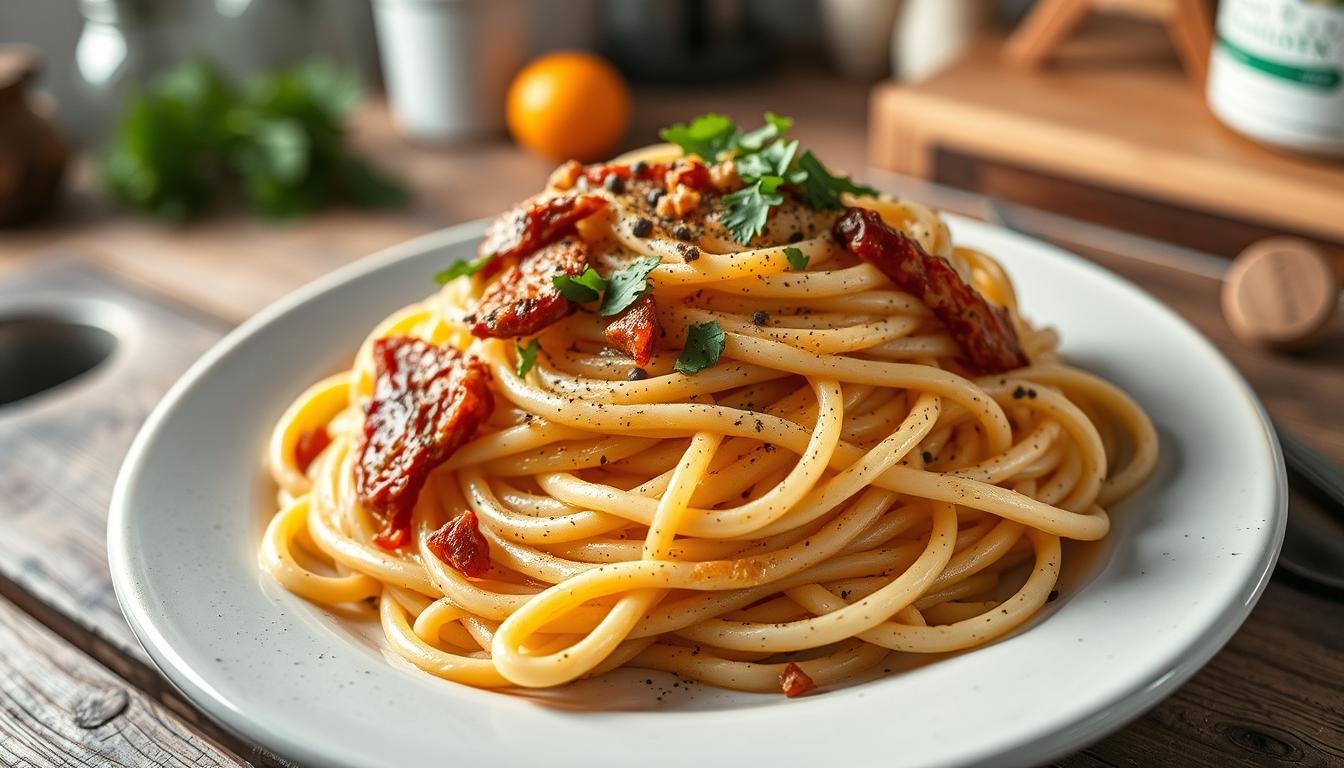As I stand in my kitchen, the scent of sizzling guanciale fills the air. It instantly takes me back to Naples’ charming streets. My grandmother taught me how to make this authentic Italian pasta dish. Today, I’m excited to share this family recipe with you.
It’s a traditional carbonara that captures the essence of Neapolitan cuisine. Let’s get started on making this beloved dish together.

Key Takeaways
- Discover the origins and evolution of the classic Roman Carbonara recipe
- Learn how to select and prepare the essential ingredients, including high-quality guanciale and Pecorino Romano cheese
- Master the perfect egg and cheese mixture for a creamy, authentic sauce
- Explore the nuances of cooking the Neapolitan spaghetti and utilizing the pasta water to achieve the ideal texture
- Avoid common mistakes and learn expert tips for plating and serving this iconic Italian dish
Understanding Traditional Carbonara’s Origins
The history of Roman cuisine and Italian food history is closely tied to the evolution of traditional pasta dishes like carbonara. This famous dish has deep roots in the Eternal City’s culinary traditions. Its origins go back centuries.
History of Roman Carbonara
Eggs were used in Neapolitan cooking to thicken soups and pasta since the 1700s. The first “carbonara” recipe was published in 1952 in a Chicago guide. In 1954, the first Italian recipe for carbonara was in “La Cucina Italiana.” It included spaghetti, egg, bacon, Gruyère cheese, and garlic.
Evolution of the Recipe
The American army brought a carbonara ancestor to Rome in 1944. In 1960, Luigi Carnacina’s recipe added guanciale and cream. Gualtiero Marchesi’s 1989 version used a quarter of a liter of cream for 400g of spaghetti. By the 1990s, carbonara became the iconic dish we know today.
Regional Variations
The Neapolitan version of spaghetti carbonara has some differences from the Roman one. But, its popularity has led to many variations in Italy and worldwide. You can find seafood, vegetarian, and vegan carbonara, showing the dish’s versatility and changing tastes.
“Carbonara, a renowned pasta dish from Rome, contains cubed guanciale, whole eggs, grated pecorino romano or Parmesan cheese, and black pepper.”
Essential Ingredients for Authentic Carbonara
Making a real Neapolitan Spaghetti Carbonara needs the right ingredients. You’ll need guanciale (cured pork cheek), Pecorino Romano cheese, fresh eggs, and spaghetti.
Guanciale gives the dish its deep, savory taste and smooth feel. It’s a key part of a classic Carbonara. Pecorino Romano cheese adds a sharp, tangy flavor. Fresh eggs make the sauce creamy and hold everything together.
Spaghetti is the pasta of choice, but rigatoni works too. It should be cooked just right, so it’s still a bit firm. This lets the sauce stick to it better.
- Guanciale (cured pork cheek)
- Pecorino Romano cheese (finely grated)
- Fresh eggs
- Spaghetti
- Black pepper (freshly ground)
- Salt (for pasta water)
With these ingredients and the right cooking, you get a true Neapolitan Spaghetti Carbonara. It’s a mix of rich, savory, and tangy tastes that people love.
The Role of Guanciale in Neapolitan Spaghetti Carbonara
Guanciale, the cured pork cheek, is key in authentic Neapolitan spaghetti carbonara. It brings a rich, smoky taste and a crispy texture. When picking guanciale, look for a firm, well-marbled cut with a deep pink color and a strong aroma.
Proper Cutting Techniques
To get the right texture in your carbonara, cut the guanciale into thin, even strips, about 1/4-inch thick. This helps the fat melt slowly, making a crispy outside and a tender inside.
Cooking Methods for Perfect Crispiness
To get the perfect crispiness, sauté the guanciale over medium heat. Cook the strips, stirring now and then, until they turn golden-brown and crispy. The fat from the guanciale will coat the spaghetti, adding a unique flavor to the sauce.
If you can’t find guanciale, you can use cured pork cheek or Italian cured meats as a guanciale substitute. But, guanciale’s unique taste and texture are hard to match. So, it’s best to use the traditional ingredient for the real Neapolitan spaghetti carbonara taste.
“Guanciale is the heart and soul of a true Neapolitan carbonara. Its rich, porky essence is irreplaceable.”
Mastering the Egg and Cheese Mixture
The heart of a creamy carbonara sauce is the egg and cheese mix. It’s all about finding the right balance. Use 2 egg yolks for every whole egg for the best texture.
For cheese, go for freshly grated Pecorino Romano or a mix of Pecorino and Parmesan. Grate it finely with a microplane. This way, it melts smoothly into the creamy carbonara sauce, giving it a velvety finish.
The trick to a smooth sauce is tempering the eggs. Slowly whisk the egg mix into hot pasta and water. This cooks the eggs gently, making a creamy, glossy sauce that sticks well to the spaghetti.
| Ingredient | Quantity |
|---|---|
| Whole Eggs | 1 |
| Egg Yolks | 2 |
| Pecorino Romano Cheese, Grated | 3/4 cup |
| Freshly Ground Black Pepper | 1 teaspoon |
Mastering tempering eggs and mixing the cheese blend right is key. It unlocks the secret to making a real creamy carbonara sauce. This sauce will take you straight to Rome’s heart.

Choosing the Right Pasta Type and Quality
When making the perfect Neapolitan Spaghetti Carbonara, the pasta you pick is key. The recipe usually calls for dried spaghetti or rigatoni. But, fresh homemade pasta can add a delicate touch.
Fresh vs. Dried Pasta Options
Fresh pasta cooks quicker than dried, so watch the time. To get the al dente feel, check it often. Save the starchy water to mix with the sauce for creaminess.
Proper Cooking Techniques
Whether you pick fresh or dried al dente pasta, cooking it right is vital. Cook it until it’s just right, so it soaks up the sauce’s flavors well.
Italy has over 350 pasta types, each with its own look and taste. When making your Neapolitan Spaghetti Carbonara, try different pasta to find the best match for the dish.
Step-by-Step Cooking Process
Making the perfect carbonara recipe is all about timing and coordination. You need to render the guanciale, cook the pasta, and mix it with the egg and cheese. It’s important to toss it well to avoid scrambled eggs and get a creamy sauce.
- Prepare the Pasta: Boil the spaghetti until it’s al dente, as the package says.
- Cook the Guanciale: Cut the guanciale into small pieces. Cook it in a skillet until it’s crispy, about 5-7 minutes. You can also add garlic for extra taste.
- Make the Sauce: Beat the eggs and mix in Pecorino Romano cheese and black pepper.
- Combine and Toss: Drain the spaghetti and mix it with the guanciale in the skillet. Pour the egg and cheese over it and toss well. Add pasta water if it’s too thick.
- Plate and Garnish: Serve the Neapolitan Spaghetti Carbonara hot. Top it with more Pecorino Romano cheese and black pepper.
The whole process should be quick and smooth. A good carbonara recipe needs all ingredients ready and a fast pace to keep flavors and textures balanced.
Common Mistakes to Avoid
Neapolitan spaghetti carbonara is a simple yet delightful dish. However, even experienced cooks can make mistakes. Knowing these common errors helps you make a perfect carbonara.
Temperature Control Tips
Temperature is key to a creamy carbonara sauce. Avoid overcooking the guanciale or scrambling the eggs. This can ruin the dish. Remove the pan from heat before adding the egg mixture. This keeps the eggs from curdling.
Sauce Consistency Solutions
Getting the sauce right is another challenge. A too-thick sauce can be gloopy, while a too-thin one is watery. To fix this, toss the pasta with the egg mixture. Add pasta water as needed for a creamy sauce.
| Common Carbonara Mistakes | Potential Solutions |
|---|---|
| Overcooking the guanciale | Remove the pan from heat before adding the egg mixture |
| Scrambling the eggs | Remove the pan from heat before adding the egg mixture |
| Sauce too thick | Add more pasta water and continue tossing |
| Sauce too thin | Keep tossing the pasta to emulsify the sauce |
Mastering temperature and adjusting the sauce fixes common issues. This way, you can enjoy a perfect pasta sauce every time you make Neapolitan spaghetti carbonara troubleshooting.
Perfect Pasta Water Management
Making the perfect Neapolitan Spaghetti Carbonara is more than just ingredients and cooking methods. It’s also about managing pasta water right. To get a creamy sauce, save a cup of starchy pasta water before draining the noodles.
The starchy liquid from the pasta is key for a smooth sauce. It helps the sauce stick to the noodles. Start by adding 1/4 cup of this water, then 1 tablespoon at a time as needed. This ensures your sauce is creamy and enhances the dish.
This step is often missed, but it’s crucial for the dish’s texture and taste. Learning to manage pasta water is essential for anyone making this Roman classic at home.
| Pasta Cooking Water Tip | Why It’s Important |
|---|---|
| Reserve about 1 cup of starchy pasta cooking water before draining | The starch in the water helps emulsify the sauce and achieve the right consistency |
| Add the reserved water gradually, about 1/4 cup at first, then 1 tablespoon at a time as needed | This ensures a smooth, creamy sauce that clings perfectly to the pasta |

Mastering pasta water management is key to a delicious Neapolitan Spaghetti Carbonara. This simple technique can turn your dish into a culinary masterpiece. Embrace it, and watch your Carbonara come to life.
Plating and Presentation Techniques
When serving the perfect Italian food presentation, detail matters as much as the recipe. Neapolitan pasta plating for carbonara should look great and stay true to its roots.
Traditional Serving Methods
Carbonara should be served on warmed plates right away. This stops the sauce from getting too thick. Use tongs to make a neat pile of pasta. This keeps its shape and texture.
Garnishing Tips
- Top with extra crispy guanciale (Italian cured pork jowl) for a nice crunch.
- Spread freshly grated Pecorino Romano cheese over the dish.
- Finish with a lot of freshly cracked black pepper to boost the flavors.
- Some chefs add a raw egg yolk on top for extra richness and looks.
By focusing on Italian food presentation and pasta plating, you can make the traditional carbonara dish stand out. This ensures a memorable meal.
Recipe Variations and Substitutions
The traditional Neapolitan Spaghetti Carbonara is a classic loved by many. But, there’s always room for creativity and new twists. If you want to make this dish your own, try these variations and substitutions.
For a creamier version, add a bit of heavy cream to the egg and cheese mix. You can also make vegetarian carbonara by using sautéed zucchini or mushrooms instead of guanciale. If guanciale is hard to find, pancetta or bacon are great substitutes.
Don’t stick to just spaghetti. Try bucatini or spaghetti alla chitarra for a different twist. Adding fresh peas or asparagus spears can also add color and texture. The options are endless when you put your own spin on this Italian favorite.
